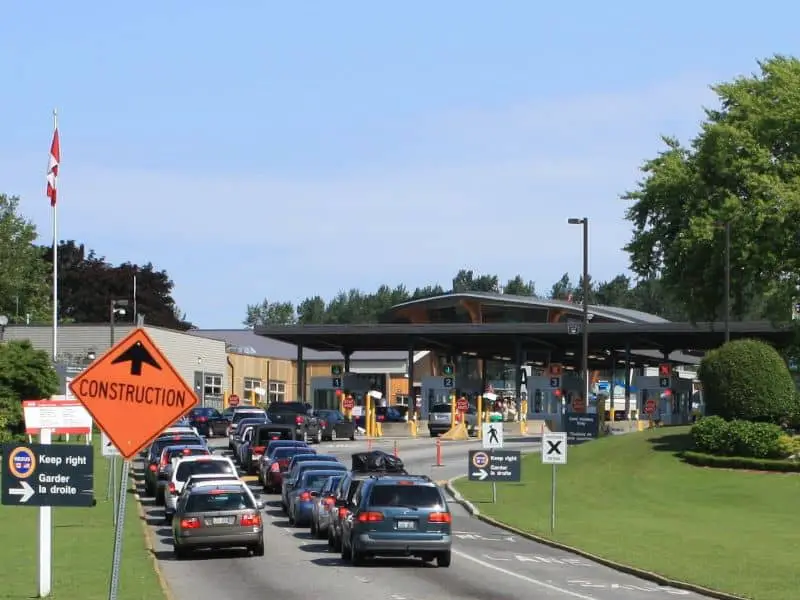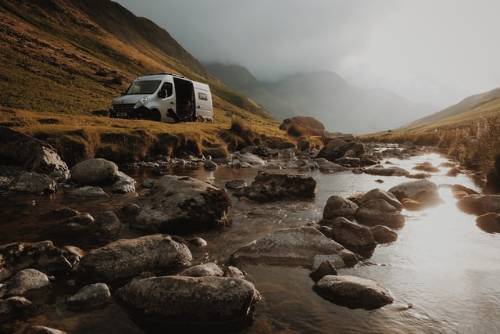Are you destined for the awe-inspiring peaks of Banff National Park? Or the bucolic beauty of Prince Edward Island?
Driving your RV into Canada isn’t something you just …. do. It takes some planning.
I remember back when you could cross into Canada with nothing more than a library card for ID, but in the 21st century, international travel is more complicated.
Thankfully, so long as you come prepared, you can enjoy this wonderful, scenic outdoor paradise!
Table of Contents
The Basics of Crossing Your RV into Canada

Relax … driving your RV into Canada isn’t as complex as it may sound.
You’ll need a stack of required documents (listed in the next section), such as a passport, vehicle registration and proof of insurance, pet rabies vaccination, etc.
You must use ArriveCan to enter into Canada! This app is available online and on iOS and Android devices.
- Using ArriveCan is both mandatory and free.
- You need to submit your information at least 72 hours before attempting to cross the border.
Some travelers do endure top-to-bottom searches of their RVs, especially if a border patrol dog smells something suspicious.
But most RV owners enter Canada to a wave and a friendly “Enjoy Canada!” greeting.
If you follow this post, you’re more likely to be the latter and not the former.
Why Travel Into Canada?
Often called “the friendliest border in the world,” the 5,525-mile border between the United States and Canada spans the West Coast, the Pacific Northwest, the “Icebox of the United States,” the Great Lakes, and New England.
Popular RVing destinations in Canada include:
- The Canadian Rockies (Banff National Park, Jasper National Park, Yoho National Park, etc.)
- Canoeing and fishing on Ontario shores
- The big cities of Vancouver, Calgary, and Montreal
Things You Should Know About Traveling in Canada
- Speed limits in Canada are measured in kph (100 kph = 62 mph)
- Fuel is sold by the liter (3.78 liters = 1 gallon)
- Both French and English are considered official languages
- RVing is popular in Canada, too! You can find developed campgrounds and primitive/dispersed camping areas all over the country. Just don’t try to park your rig on the side of the highway (no go).
Required Documents to Drive Your RV Into Canada
- A valid passport (or acceptable travel document) for you and every member of your part
- A driver’s license, proof of insurance, and copy of your vehicle’s registration.
- Don’t forget! This includes ALL your vehicles, including truck campers, towable RVs, toads, etc.
- Health screening information for you, family, and your pets.
This information is critical, especially when entering the country. If you lose documentation while inside the country, generally, you’ll still be allowed entry to your home country. But additional screening will likely be required.
You must submit your information via ArriveCan at least 72 hours before crossing the border. You will be required to provide details of your itinerary, possibly including locations, dates, and contact information (such as physical addresses and phone numbers).
If you’re a grandparent traveling with grandchildren, best to obtain a Letter of Parental Consent to prove your stewardship of the kids.
Know Your RV!
You should know the width, length, height, and weight of your as-loaded RV. Make sure your RV weight is within its GVWR!
Best to memorize (or write down) the license numbers of your tow vehicle, RV, dinghy – any and all vehicles crossing the border! (Don’t forget any vehicles inside your RV, like a snowmobile!)
Bring copies of your vehicle[s] registration and proof of insurance for all vehicles.
What About Renting an RV?
- If you attempt to cross the border in a vehicle that is not yours, expect additional paperwork and precautions.
- If you’re renting an RV, you’ll need booking voucher, rental agreement, and insurance certificate. You might also need additional written permission to drive your rental RV into Canada if the rental policy doesn’t expressly allow it.
If You Have Pets
The Canadian government can refuse entry to your pets!
- Bring copies of your pet’s most up-to-date vaccination records.
- Don’t bring excessive amounts of pet food (no more than 20 kg or 44 lbs), and don’t feed the food to any other animals in the country!
- Store the pet food in the same bag it was sold in (aka, no tupperware).
- If you’re traveling with anything besides cats or dogs, you may require additional documentation for, say, exotic pets or birds.
What About COVID-19 Regulations?
Information surrounding international travel in lieu of COVID-19 is rapidly changing. Please don’t trust any blog post, especially if it’s older than 3 months!
Instead, we invite you to visit the official Canadian government website here. As of February 7, 2022, fully vaccinated individuals are (usually) allowed to travel into Canada.
There are still rules aplenty once you’re in the country! You must:
- Wear a mask at all times when in public spaces
- Maintain a list of all close contacts for your first 14 days in Canada
- Monitor yourself for signs and symptoms of COVID-19
You will also need to provide a plan for a 14-day quarantine period in case you test positive for COVID.
There are quite a few more rules concerning RV travel between the US and Canada during the COVID pandemic. Stay abreast on the latest instructions using ArriveCan.
Common Questions You’ll Be Asked

Here are a smattering of the questions most commonly asked. Be prepared to answer them.
- Where do you live?
- Answer: Tell them your domicile. Don’t say, “We live in our RV.”
- What is the purpose of your visit?
- Answer: Tell them the Sparknotes version of your itinerary – where you’re
- headed and for how long.
- What is your citizenship status?
- Answer: Tell them you are a U.S. citizen or permanent resident, if applicable.
- Do you have any alcohol on board?
- See Customs information below.
- What do you do for a living?
- Self-explanatory.
- Do you have any pets on board?
- See above notes on pets.
- Who is traveling in the vehicle?
- See above notes on parental consent forms.
- Do you have any firearms?
- See below notes on bringing firearms into Canada.
Proper Etiquette When Crossing the Border
Crossing the US-Canadian border for the first time can be unnerving. Thankfully, so long as you don’t have anything to hide, you have nothing to worry about!
You also don’t want to lose time while the Border Patrol searches your entire 40-ft 5th wheel, though. So mind your manners, and you’ll get through faster!
- Stop using your cell phone. Turn down any music. Turn off any distractions, like the TV.
- Be polite, courteous, open, and cooperative.
- Take off your sunglasses! No need to look like a MIB operative. Go for the meek and mild look.
- Keep your seatbelt buckled.
- Roll down all the windows. If you’re using sun shades or curtains, open them up, too.
- Don’t be offended if Border Patrol asks detailed questions about your kids. They’re on the lookout for child abduction.
- Stay in the car lane, not the Big Truck lane! (so long as your rig isn’t too tall for the canopy)
- Only answer questions you are asked. Look ‘em in the eye!
Customs Info for RV Travelers Crossing into Canada
Do Feel Free to Bring These Items
- Snacks, baked goods, condiments, canned goods, coffee, etc.
- Outdoor and camping gear
- Photography gear
- Personal medical prescriptions
- Hand tools and repair kits
- First-aid kits
Try Not to Bring These Items
While you can bring certain quantities of beer, alcohol, and cigarettes, we recommend crossing the border without them. You’ll have to declare them and show proof of quantity. It’s not worth the time.
On a similar note, avoid bringing fruits, vegetables, houseplants, seeds, soil, firewood, and other flora. Canada has strict customs rules for importing anything organic that could introduce invasive species, foreign animal diseases, and plant pests. If you plan to bring any of these items, you’ll need to do some extra research about what’s allowed. Most of these items will at least require screening and inspection, which will prolong your border crossing.
Best to enter the country with an empty fridge! Otherwise, you’ll likely have to declare your food, and an agent will need to inspect your fridge. Expect most of your fridge to be unceremoniously tossed in the trash.
Wait to go grocery shopping until you’re in the country!
Don’t Bring These Items into Canada in Your RV
- No more than $10,000 cash (makes you look like a drug runner)
- Mace, pepper spray, etc.
- Firewood (danger of invasive species and diseases)
- Firearms (even if you have a U.S. state permit)
- Cannabis products
- Fireworks and explosives
- Fruits, meats and vegetables (danger of invasive species and diseases)
- Alcohol. No more than 5 liters or two bottles.
Word of Warning on Firearms
A special note on firearms (lookin’ at you, Texas!):
- Canada has no Second Amendment right. While you’re in Canada, you have no constitutional right to possess any firearm weapon.
- Restricted firearms include pepper spray, mace, butterfly knives, and most handguns. You must obtain in advance an Authorization to Transport (ATT) permit from a Provincial Chief Firearms Officer. You’ll have to pay $50 and sign a Firearms Declaration form at the border, too. Best practice: Just don’t do it. Your Conceal and Carry permit doesn’t matter here.
- Unrestricted firearms include most sportsman firearms like hunting rifles and shotguns. Unrestricted doesn’t mean laisseze-faire, though. You’ll need to bring and sign a Non-Resident Firearm Declaration Form at the border, declare the gun, transport it unloaded, pay the form fee, etc.
- You’ll need to show a purpose for the weapon. Allowed intents include hunting and wilderness protection. Self-defense does not count as an approved purpose.
- More than three guns, regardless of restriction status, will likely not be allowed.
Don’t mess with Border Patrol. Unallowed firearms will be confiscated and destroyed with no reimbursement. And agents have discretionary power. If they don’t trust you, they don’t have to let you (or your gun) into the country. If it’s your first time crossing the border AND you’ll traveling with a firearm, they may run a background check for your criminal history.
Err on the safe side – begin the application process three months before entering the country.
What if you can’t bring your gun[s] into Canada? Don’t stash them in the woods, somewhere. Instead, rent a local safety deposit box until you come back!
For more information, listen to what Canada says.
Andy Herrick is a blogging nerd, #8 Enneagram, wannabe bread baker, INTJ, RV industry professional, and small business entrepreneur. He can be found hanging out with his lovely wife and family, skiing, cycling, climbing, hiking, and convincing anyone who will listen why dogs aren’t really that great of pets. Also, he runs this website.
-
Andyhttps://changingears.com/author/andrew-herrick/
-
Andyhttps://changingears.com/author/andrew-herrick/
-
Andyhttps://changingears.com/author/andrew-herrick/
-
Andyhttps://changingears.com/author/andrew-herrick/










